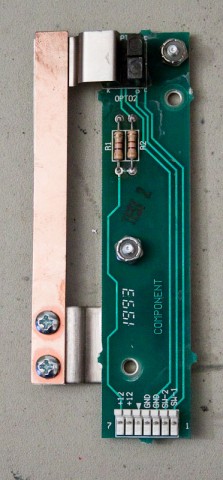Location: Littleton/Denver, CO.
Symptoms: Flipper problems, ROM checksum error, Proximity Sensor error.
I started with the ROM checksum error. I re-seated the game ROM in U6 and the other socketed parts, with no improvement. I programmed a new 27C040 with the game code (decided to try the 9.4H version) and replaced the ROM and the problem was solved. I verified the code in the old ROM and there were several bits that had reverted back to 1, which was causing the checksum error. This probably caused the game to lock up occasionally, which was one of the complaints.
The proximity sensor senses when a normal metal ball is delivered to the shooter lane (as opposed to the Power Ball which is made of ceramic). It was simply out of adjustment and not located close enough to the ball to sense it.
The flippers had the most problems. Neither of the left flippers were working properly. The top flipper was kicking out, but not holding and the bottom flipper was vibrating and buzzing and weak. At first I thought the two problems were related and that there may have been a driver problem on the Fliptronic board. But that wasn’t the case.
The upper flipper had a broken wire on the holding coil. I resoldered it the coil and it solved that problem.
The lower flipper had a more difficult problem to find. I hooked the oscilloscope up to the flipper driver output of the Fliptronic board. It was rapidly pulsing off and on. When I disconnected the flipper connector, the problem went away and there was steady power to the connector. I checked the coil resistance and found no problems. It turned out to be the flipper button opto board.
Normally when pressing the flipper button, the optical path opens and the phototransistor begins pulling the signal down to ground from 12 volts. When the voltage falls below 5 volts, it triggers the flipper driver via the processor. A good opto circuit will pull down to below 1 volt. This was only pulling down to about 4.8 volts, which was too close to the threshold of 5 volts. When the flipper engerized, the ground probably shifted a little causing the circuit to think the voltage had risen above 5 volts, thus shutting the flipper off. As soon as the flipper shut of, the voltage would fall back below 5 and energize the flipper again. A vicious circle, which caused the output to pulse off and on very rapidly.
I tried cleaning the opto interrupter, but that didn’t help. The opto interrupters for this board are no longer available (as far as I can tell). The only option was to replace the board. Great Lakes Modular offers a totally redesigned flipper button board that utilizes magnetic sensors instead of optical. The pinball machine owner opted to give it a try. I ordered one and installed it.
The board needs to be adjusted once it’s installed. The LEDs on the board really help this process. However, to adjust it, you need to slide the magnet into different positions and I found it really sensitive. Just a 1/16″ movement will cause it to go out of adjustment. Great Lakes recommends taping the magnet after getting it adjusted. I opted to glue it. We’ll see how long it lasts. Once adjusted, it had the same feel and response as the right side flipper button.

